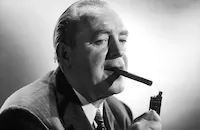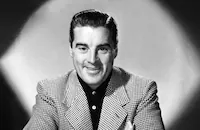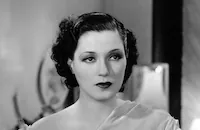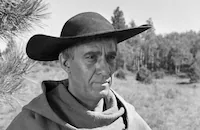In Caliente

Brief Synopsis
Cast & Crew
Lloyd Bacon
Dolores Del Rio
Pat O'brien
Leo Carrillo
Edward Everett Horton
Glenda Farrell
Film Details
Technical Specs

Synopsis
Larry MacArthur, the editor and publisher of a New York magazine, has become engaged to gold-digging Clara. To save him from his approaching marriage, his partner, Harold Brandon, brings him secretly to Agua Caliente in Mexico for a vacation. Larry is determined to return to Clara and New York until he spots attractive Rita Gomez. Not knowing that she is dancer La Espanita, the recipient of one of Larry's bad reviews, Harold hires Rita to help him keep Larry in Mexico. At first she is insulted that Harold would imagine she is for sale, but when she learns who Larry is, she plans to make him fall in love with her as revenge. As Rita and Larry get acquainted, however, they both fall in love. Rita offers to dance for free and, just before her performance, hands Larry a copy of his review. When he realizes what happened, Larry apologizes, swearing that she is the only woman he ever loved. Just as they are about to kiss, Clara, who has followed Larry to Mexico, walks through the door. Misunderstanding, Rita leaves. Larry pursues Rita while Clara and Harold follow in another car. Clara, learning of Harold's wealth, takes advantage of their arrest by the police and marries him, clearing the way for the marriage of Rita and Larry.

Director

Lloyd Bacon
Cast

Dolores Del Rio

Pat O'brien

Leo Carrillo

Edward Everett Horton

Glenda Farrell
The Demarcos

Phil Regan

Winifred Shaw
Luis Alberni
George Humbert
Harry Holman

Soledad Jimenez

Herman Bing
Florence Fair

Judy Canova
The Canova Family
Dorothy Dare
Olive Jones
John Hyams

Martin Garralaga
Henry De Silva
Milton Kibbee
Sam Appel
George Regas
Alfonso Pedroza
Agostino Borgato
Chris Pin Martin
C. I. Dafau
Carlos Salazar
L. R. Felix
Florence Fair
James Donlan
Clayton E. Kirby
George Mendoza
Juan Duval
Selmer Jackson

William Davidson
Crew
George Barnes
Busby Berkeley
Ralph Block
Edward Chodorov
Mort Dixon
Al Dubin
Warren Duff
Julius Epstein
Leo F. Forbstein
James Gibbon
Robert M. Haas
Ray Heindorf
Orry-kelly
Sol Polito
Jerry Wald
Harry Warren
Allie Wrubel

Videos
Movie Clip



Trailer
Film Details
Technical Specs

Articles
In Caliente
The latter number was also highly appropriate for this tale of a fiery Latin dancer (Dolores del Rio) who travels to Agua Caliente, a popular Mexican resort, after receiving a scathing review from a New York critic, only to find herself falling for the man (Pat O'Brien), who's on the run from gold-digging fiancée Glenda Farrell. Of course the plot was just a flimsy excuse for the musical numbers, and with Busby Berkeley doing the staging, nobody cared about the story.
For the film's big number, "Muchacha," Dubin wrote a lyric that prompted New York Times critic Frank Nugent to accuse him of "hitting below the Equator" with lines like "Muchacha, at last I've gotcha where I wantcha, muchacha." Berkeley created one of his impossible stage performances for the number. He turned a hotel patio into a bandits' lair complete with cowboys leaping over a blazing campfire and a café brawl reminiscent of a similar scene in the "Shanghai Lil" number from Footlight Parade (1933). During filming, something went wrong, and Berkeley whistled to stop the action. But the whistle startled the eight horses, which took off out of the soundstage and tore through the Warner Bros.' back lot past the studio commissary. Noticing the commotion, one wag looked up from lunch and quipped," There go Berkeley's horses. He must have dismissed 'em for lunch. Look at 'em go. He must be working their tails off." (Quoted in Tony Thomas, The Busby Berkeley Book, 1973).
For the "Lady in Red" number the female chorus actually dressed in blue, which looked redder than red in black and white. Lead singer Wini Shaw had just scored a hit in Gold Diggers of 1935 (1935), introducing Dubin and Warren's Oscar®-winning "Lullaby of Broadway." Also prominently featured was the dancing team The De Marcos and country comedienne Judy Canova in her first feature film (a year earlier she had made her debut -- with her family act, The Canovas -- in the Ruth Etting short "The Song of Fame"). "The Jenny Lind of the Ozarks" provides one of the film's highlights as she vamps co-star Edward Everett Horton with a country-western version of the song, complete with yodeling.
With all of these specialties on hand, it was rather hard for the film's actual leads, O'Brien and Del Rio, to make an impact. That hardly mattered for O'Brien, a studio workhorse who would churn out nine films in 1935, starring in some and supporting good friend James Cagney in others. For Del Rio, the film was part of a long career slide following her years of stardom in silent films, when she was billed as "The Female Rudolph Valentino." With opportunities fading in Hollywood, she would return to her native Mexico in the '40s to help spearhead the golden age of Mexican cinema there.
Del Rio was far from the only Latino performer in this Mexican-set musical. Leo Carrillo, a descendant of California's original settlers, played a prominent role as her father, while Spanish-born character actors Luis Alberni and Soledad Jimenez took smaller roles. One Hollywood Latin who failed to make the final cut was Rita Cansino, the future Rita Hayworth, whose brief appearance, shot before she signed with Fox later that year, didn't make it into the film.
Producer: Edward Chodorov
Director: Lloyd Bacon
Screenplay: Jerry Wald, Julius J. Epstein
Based on the story "Caliente" by Ralph Block and Warren Duff
Cinematography: Sol Polito, George Barnes
Art Direction: Robert M. Haas
Music: Leo F. Forbstein
Cast: Dolores del Rio (Rita Gomez), Pat O'Brien (Lawrence "Larry" MacArthur), Leo Carrillo (Jose Gomez), Edward Everett Horton (Harold Brandon), Glenda Farrell (Clara), Phil Regan (Pat Casey), Winifred Shaw (Singer, "The Lady in Red"), Herman Bing (Mexican Florist), Luis Alberni (Magistrate), Henry De Silva (Waiter), Judy Canova (Novelty Singer).
BW-84m.
by Frank Miller

In Caliente
Quotes
Trivia
Before the movie's release, the music was played on the radio for advertising purposes.
The costumes in "The Lady in Red" number were actually blue, but looked "red" when photographed in black and white.
Notes
The film's working title was Caliente. Variety notes that the film's songs were played over the radio prior to the film's opening as a merchandising ploy. New York Times made special comment on one Busby Berkeley number in which a hotel patio was transformed into a bandit cave with blazing campfires, a rodeo and a mountain range in the background. According to studio notes, the costumes in "The Lady in Red" number were actually a shade of blue that looked red when photographed on black and white film. Scenes in the movie were filmed on location in Agua Caliente, Mexico. According to a modern source, Rita Cansino was in the cast of the film.















